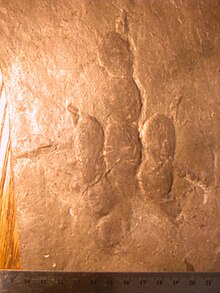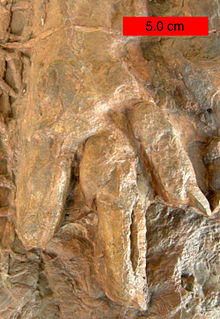Gwyneddosaurus is a possibly invalid genus of extinct aquatic tanystropheid reptile. The type species, G. erici was described in 1945 by Wilhelm Bock, who identified it as a coelurosaurian dinosaur related to Podokesaurus. Its remains were found in the Upper Triassic Lockatong Formation of Montgomery County, eastern Pennsylvania, and the holotype includes skull fragments, several vertebra, ribs, gastralia, partial shoulder and hip bones, and several forelimb and hindlimb elements found in soft shale, while the paratype includes a femur and a tibia. The type specimen is ANSP 15072 and it was discovered by Bock's four-year-old son while the paratype is only listed as ?(ASNP coll.). It was not a large animal; the type skeleton was estimated by Bock as 18 centimetres (7.1 in) long, and its thigh bone was only 23 millimeters long (0.91 in).

Eubrontes is the name of fossilised dinosaur footprints dating from the Late Triassic and Early Jurassic. They have been identified from France, Poland, Slovakia, Czech Republic, Italy, Spain, Sweden, Australia (Queensland), US, India, China and Brazil (South).

Otozoum is an extinct ichnogenus of sauropodomorph dinosaur from the Late Triassic-Middle Jurassic sandstones. Footprints were made by heavy, bipedal or, sometimes, quadrupedal animals with a short stride that walked on four toes directed forward. These footprints are relatively large, over 20 cm in pes length. Otozoum differs from Plateosaurus by having a notable homopody.
The Blackstone Formation is a geologic formation of the Ipswich Coal Measures Group in southeastern Queensland, Australia, dating to the Carnian to Norian stages of the Late Triassic. The shales, siltstones, coal and tuffs were deposited in a lacustrine environment. The Blackstone Formation contains the Denmark Hill Insect Bed.
Atreipus is an ichnogenus or trace fossil attributed to early Ornithischian dinosaurs. Its significance for Triassic biostratigraphy has earned it some fame. Reptile footprint faunules from the early Mesozoic Newark Supergroup of eastern North America.
Anticheiropus is an ichnogenus of dinosaur footprint belonging to a saurischian. It has only been discovered in Massachusetts. Two ichnospecies are known : A. hamatus and A. pilulatus, both discovered around 1863 and named by Edward Hitchcock in 1865.
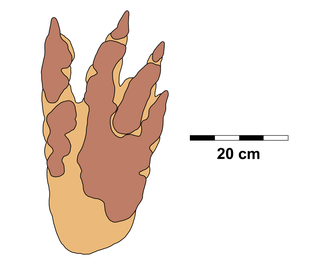
Macropodosaurus is an ichnogenus of therizinosaurid footprints from the Late Cretaceous of Asia, North America and Poland. The ichnogenus is currently monotypic only including the type ichnospecies M. gravis, described and named in 1964.
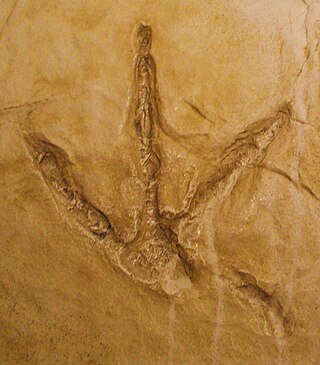
Saurexallopus is an ichnogenus of four-toed theropod footprints from the Late Cretaceous period. The type ichnospecies is S. lovei, named and described in 1996 from the Harebell Formation. The taxon was originally named Exallopus, but later renamed as Saurexallopus as the former was preoccupied by a polychaete. A second species, S.zerbsti, was named and described in 2004 from the Lance Formation. In 2012 a four-toed track from the Cantwell Formation was referred to Saurexallopus indet. It was also suggested that Saurexallopus was produced by a therizinosaur taxon. In 2013 based on skeletal proportions it was suggested that the ichnotaxon was instead produced by an oviraptorosaur taxon. In 2014 a third species was named, S.cordata, from the Wapiti Formation. In 2018 several tracks from the Blackhawk Formation were referred to Saurexallopus indet.
Abelichnus is an extinct ichnogenus of dinosaur footprint from the Candeleros Formation and the Rio Limay Formation. The type ichnospecies, Abelichnus astigerrae, was first discovered in Argentina in 1987 and was recorded as the biggest known dinosaur footprint ever discovered. Abelichnus probably grew to a size of 12.5-13 meters long.
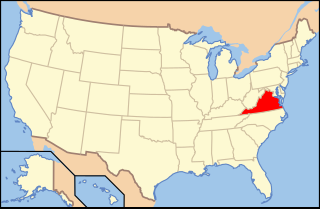
Paleontology in Virginia refers to paleontological research occurring within or conducted by people from the U.S. state of Virginia. The geologic column in Virginia spans from the Cambrian to the Quaternary. During the early part of the Paleozoic, Virginia was covered by a warm shallow sea. This sea would come to be inhabited by creatures like brachiopods, bryozoans, corals, and nautiloids. The state was briefly out of the sea during the Ordovician, but by the Silurian it was once again submerged. During this second period of inundation the state was home to brachiopods, trilobites and entire reef systems. During the mid-to-late Carboniferous the state gradually became a swampy environment.
The Tomanová Formation is a Late Triassic geologic formation in Poland and Slovakia. Fossil theropod tracks have been reported from the formation.
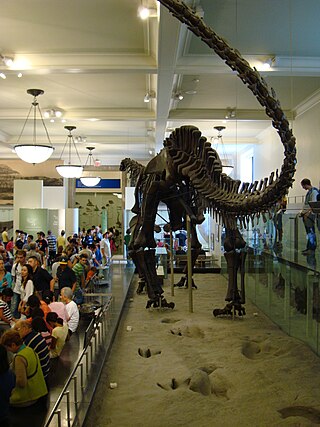
The 20th century in ichnology refers to advances made between the years 1900 and 1999 in the scientific study of trace fossils, the preserved record of the behavior and physiological processes of ancient life forms, especially fossil footprints. Significant fossil trackway discoveries began almost immediately after the start of the 20th century with the 1900 discovery at Ipolytarnoc, Hungary of a wide variety of bird and mammal footprints left behind during the early Miocene. Not long after, fossil Iguanodon footprints were discovered in Sussex, England, a discovery that probably served as the inspiration for Sir Arthur Conan Doyle's The Lost World.

The 19th century in ichnology refers to advances made between the years 1800 and 1899 in the scientific study of trace fossils, the preserved record of the behavior and physiological processes of ancient life forms, especially fossil footprints. The 19th century was notably the first century in which fossil footprints received scholarly attention. British paleontologist William Buckland performed the first true scientific research on the subject during the early 1830s.
This article records new taxa of trace fossils of every kind that are scheduled to be described during the year 2019, as well as other significant discoveries and events related to trace fossil paleontology that are scheduled to occur in the year 2019.
Gwyneddichnium is an ichnogenus from the Late Triassic of North America and Europe. It represents a form of reptile footprints and trackways, likely produced by small tanystropheids such as Tanytrachelos. Gwyneddichnium includes a single species, Gwyneddichnium major. Two other proposed species, G. elongatum and G. minore, are indistinguishable from G. major apart from their smaller size and minor taphonomic discrepancies. As a result, they are considered junior synonyms of G. major.

Bellatoripes is an ichnogenus of footprint produced by a large theropod dinosaur so far known only from the Late Cretaceous of Alberta and British Columbia in Canada. The tracks are large and three-toed, and based on their size are believed to have been made by tyrannosaurids, such as Albertosaurus and Daspletosaurus. Fossils of Bellatoripes are notable for preserving trackways of multiple individual tyrannosaurids all travelling in the same direction at similar speeds, suggesting the prints may have been made by a group, or pack, of tyrannosaurids moving together. Such inferences of behaviour cannot be made with fossil bones alone, so the record of Bellatoripes tracks together is important for understanding how large predatory theropods such as tyrannosaurids may have lived.
Wakinyantanka is an ichnogenus of footprint produced by a large theropod dinosaur from the Late Cretaceous Hell Creek Formation of South Dakota. Wakinyantanka tracks are large with three long, slender toes with occasional impressions of a short hallux and narrow metatarsals. Wakinyantanka was the first dinosaur track to be discovered in the Hell Creek Formation, which remain rare in the preservational conditions of the rocks. The potential trackmakers may be a large oviraptorosaur or a small tyrannosaurid.

Brachychirotherium is an ichnogenus, a form taxon based on footprints. It is a type of chirothere, a term referring to the footprints of five-toed Triassic reptiles with a short fifth digit, leaving an appearance similar to a reverse human hand print. Brachychirotherium was first characterized from fossils found in Triassic beds in Germany, but has since been found in France, South Africa, Argentina, Peru, Bolivia, and North America.
Rhynchosauroides is an ichnogenus, a form taxon based on footprints. The organism producing the footprints was likely a lepidosaur and may have been a sphenodont, an ancestor of the modern tuatara. The footprint consists of five digits, of which the fifth is shortened and the first highly shortened.
Farlowichnus is an ichnogenus of small theropod dinosaur footprint. It includes a single species, F. rapidus, known from prints found in the Early Cretaceous Botucatu Formation of Brazil. Farlowichnus is known from several fossil trackways that indicate that it was likely a cursorial animal that was well-adapted to desert environments.
